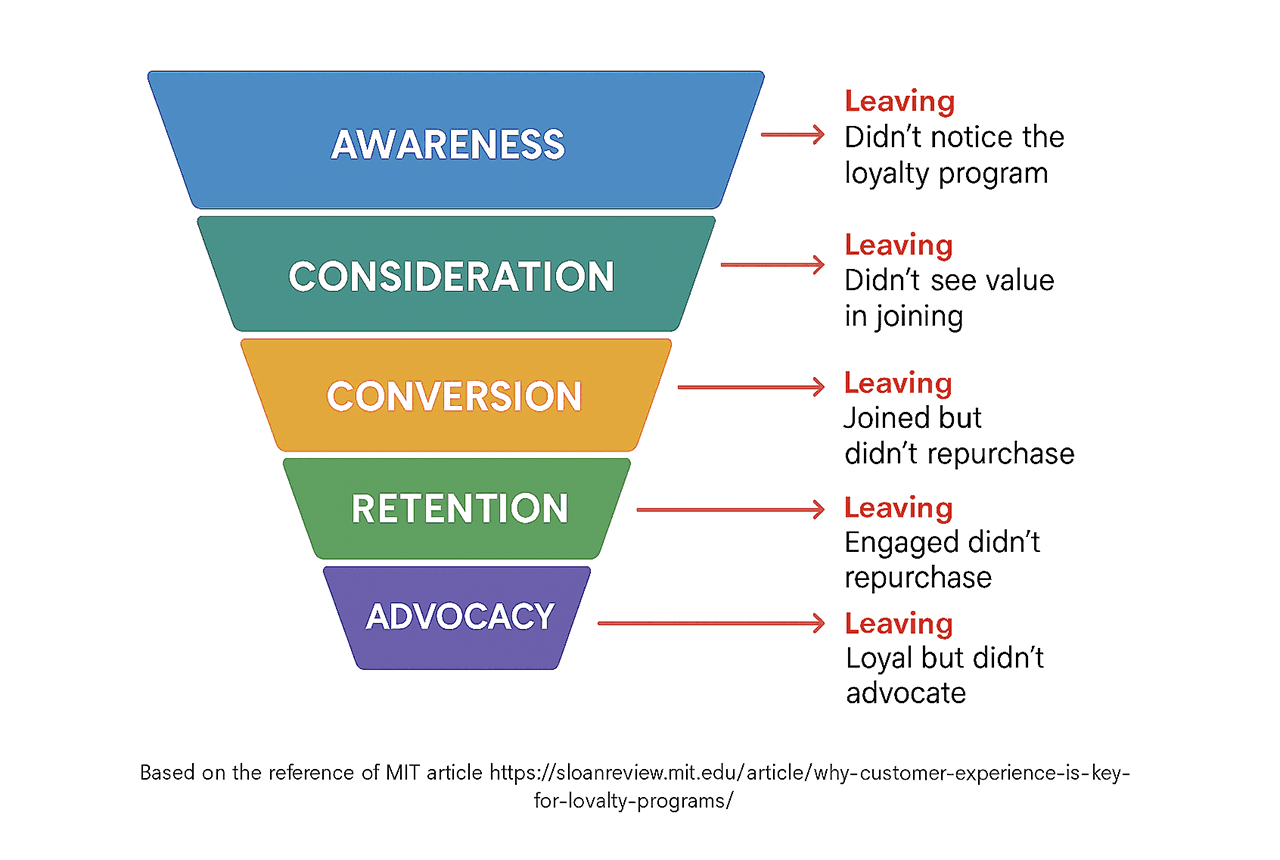The Customer Loyalty Funnel: How Shoppers Move from Awareness to Advocacy

In today's competitive ecommerce landscape, brands invest millions in loyalty programs, yet many fail to achieve the engagement they desperately need. According to SaasQuatch research, one of the most critical mistakes brands make is failing to analyse their program's performance and customer behaviour patterns once the program is launched. This oversight leads to inactive loyalty programs where customers remain stuck in the early stages, never progressing to become true brand advocates.
The solution lies in understanding the customer loyalty funnel a strategic framework that maps the complete customer journey from initial brand awareness to passionate advocacy. By recognizing where customers stand in this funnel, brands can implement targeted strategies that guide shoppers through each stage, transforming casual browsers into loyal advocates who drive sustainable business growth.
What is a Customer Loyalty Funnel?
The customer loyalty funnel is a systematic framework that visualizes how customers progress through different levels of engagement with a brand, ultimately moving from initial awareness to active advocacy. Unlike traditional sales funnels that end at purchase, the loyalty funnel extends far beyond the transaction, focusing on long-term relationship building and customer lifetime value maximization.
This strategic model helps businesses understand customer behaviour patterns, identify engagement bottlenecks, and create targeted interventions that nurture deeper relationships.
The Five Stages of the Customer Loyalty Funnel
Stage 1: Awareness
At this foundational stage, potential customers first encounter your brand through various touchpoints including social media, advertising, word-of-mouth referrals, or content marketing. The primary goal is to create memorable first impressions that differentiate your brand from competitors.
Stage 2: Consideration
Customers begin actively researching your products or services, comparing options, and evaluating how your offerings align with their needs. They might browse your website, read reviews, or engage with your content without making immediate purchasing decisions.

Stage 3: conversion
The critical conversion moment where interested prospects become paying customers. This stage involves removing friction from the buying process and providing confidence-building elements like testimonials, guarantees, or personalized recommendations.
Stage 4: Loyalty
Customers make repeat purchases and develop habitual buying patterns with your brand. They demonstrate consistent engagement with your loyalty program, respond positively to marketing campaigns, and show preference for your brand over competitors.
Stage 5: Advocacy
The highest tier of customer engagement where loyal customers actively promote your brand to their networks. They write positive reviews, share content on social media, refer new customers, and become unpaid brand ambassadors who drive organic growth.
According to MIT Sloan Management Review research, successful customer experience strategies that focus on emotional connection and personalized engagement are key drivers for moving customers through these progressive stages toward advocacy.
Why Every Ecommerce Brand Must Implement the Customer Loyalty Funnel
The customer loyalty funnel has become essential for ecommerce success due to several compelling business realities:
Cost Efficiency: According to Harvard Business Review research, acquiring a new customer costs 5-25 times more than retaining an existing one. The funnel helps brands focus resources on nurturing existing relationships rather than constantly acquiring new customers.
Revenue Impact: Research by Frederick Reichheld of Bain & Company shows that increasing customer retention rates by just 5% can increase profits by 25-95%. The funnel provides a roadmap for converting occasional buyers into frequent purchasers.
Market Dynamics: Studies indicate that customers have increasingly low tolerance for poor experiences, with many switching to competitors after minimal friction. The loyalty funnel helps brands create consistently positive experiences that retain customers in increasingly competitive markets.
Program Effectiveness: According to Bond Brand Loyalty research, 79% of consumers say loyalty programs make them more likely to continue doing business with brands. However, simply having a program isn't enough. The funnel framework ensures that loyalty initiatives actively move customers toward deeper engagement rather than creating passive participation.
Emotional Connection: Research by Capgemini found that emotionally engaged customers have a 306% higher lifetime value and are 3 times more likely to recommend a product or service. The funnel approach helps brands build these emotional connections systematically across all customer touchpoints.
Strategic Implementation at Every Funnel Stage
Awareness Stage Strategies
Content Marketing Excellence: Create valuable, educational content that addresses customer pain points before they're ready to buy. Focus on SEO-optimized blog posts, how-to guides, and industry insights that establish thought leadership.
Social Media Presence: Maintain active, engaging social media profiles that showcase brand personality and values. Use platform-specific content strategies and engage authentically with your community.
Influencer Partnerships: Collaborate with micro-influencers and industry experts who align with your brand values to reach new audiences through trusted voices.
Interest Stage Strategies
Email Marketing Sequences: Develop automated email campaigns that nurture prospects with relevant product information, customer testimonials, and exclusive offers based on their browsing behaviour.
Retargeting Campaigns: Implement sophisticated retargeting strategies that serve personalized ads to website visitors, featuring products they viewed or complementary items that match their interests.
Interactive Content: Create product configurators, quizzes, or virtual try-on experiences that help prospects visualize how your products fit their specific needs.
Purchase Stage Strategies
Streamlined Checkout: Minimize cart abandonment with simplified checkout processes, multiple payment options, and transparent pricing including shipping costs.
Social Proof Integration: Display customer reviews, ratings, and user-generated content prominently throughout the purchasing journey to build confidence.
Limited-Time Incentives: Offer strategic discounts, free shipping, or bonus items that create urgency while maintaining perceived value.
Loyalty Stage Strategies
Tiered Reward Systems: Loyalty program members are 59% more likely to choose a brand over a competitor. Create multi-level programs that offer increasingly valuable benefits as customers progress through different tiers.
Personalized Communications: Use customer data to send highly relevant product recommendations, birthday offers, and milestone celebrations that make customers feel valued as individuals.
Exclusive Access: Provide early access to new products, special sales, or VIP customer service that makes loyalty program members feel privileged and appreciated.
Advocacy Stage Strategies
Referral Programs: 49% use their program to increase word of mouth referrals. Create compelling referral incentives that reward both existing customers and new prospects they bring to your brand.
User-Generated Content Campaigns: Encourage customers to share photos, videos, or reviews featuring your products, and showcase this content across your marketing channels.
Community Building: Foster brand communities through exclusive Facebook groups, loyalty member events, or customer advisory panels that give advocates platforms to share their enthusiasm.
Success Stories: Brands Mastering the Loyalty Funnel
Amazon Prime: Beyond Transactional Loyalty
Amazon transformed customer loyalty by creating an ecosystem that delivers value at every funnel stage. Prime membership begins with awareness of shipping benefits but evolves into loyalty through streaming content, exclusive deals, and convenience features. Many Prime members become advocates, actively recommending the service to friends and family because the value proposition extends far beyond individual transactions.
Sephora Beauty Insider: Community-Driven Advocacy
Sephora's Beauty Insider program demonstrates how brands can create advocacy through community building. Members progress from occasional shoppers to passionate beauty enthusiasts who share reviews, tutorials, and product recommendations. The brand's tiered system (Insider, VIB, Rouge) creates aspiration for higher status while their mobile app and in-store experiences maintain consistent engagement across all touchpoints.
Common Mistakes Brands Make
Treating Loyalty as a One-Size-Fits-All Solution
Many brands create generic loyalty programs without considering customer segmentation or funnel stage differences. This approach fails to address the specific needs and motivations of customers at different engagement levels, resulting in poor program performance and customer dissatisfaction.
Focusing Only on Transactional Rewards
Brands often emphasize points, discounts, and cashback without building emotional connections or community engagement. While transactional benefits can drive short-term behaviour, they don't create the deep loyalty needed for sustainable advocacy.
Neglecting the Advocacy Stage
Most brands invest heavily in acquisition and conversion but fail to capitalize on their most valuable customers advocates. They miss opportunities to amplify word-of-mouth marketing and organic growth through structured referral programs and community building initiatives.
Ignoring Cross-Channel Integration
Loyalty programs that exist in isolation from other marketing efforts create disconnected customer experiences. Successful funnel implementation requires seamless integration across email, social media, mobile apps, and in-store experiences.
Final Thoughts
The customer loyalty funnel represents a fundamental shift from transactional thinking to relationship building in ecommerce. As consumer expectations continue evolving and competition intensifies, brands that master this framework will create sustainable competitive advantages through deeper customer connections and higher lifetime values.
Success requires viewing the funnel not as a linear progression but as a dynamic system where customers can enter at different stages and progress at varying speeds. The most effective approaches combine data-driven insights with human-centred design, creating experiences that feel personally relevant rather than generically promotional.
64% of consumers want brands to connect with them and share their values, indicating that future loyalty strategies must extend beyond rewards to encompass shared purpose and authentic engagement. Brands that embrace this holistic approach to the customer loyalty funnel will transform casual shoppers into passionate advocates who drive both immediate revenue and long-term growth.